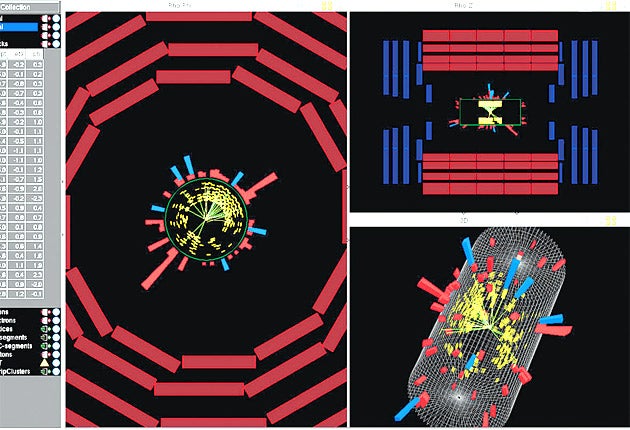Scientists take the first step in unlocking origins of universe
After 10 years – and £6bn – the first particles finally smash into each other in the Large Hadron Collider

After embarrassing breakdowns caused by bread-dropping birds and hugely expensive repairs, the world's biggest science experiment – the Large Hadron Collider – has suddenly burst into life and smashed together proton beams for the first time.
Scientists operating the giant £6 billion machine at Cern, the nuclear research body near Geneva, said yesterday that they had finally succeeded in making low energy proton collisions, which could eventually provide clues about the first Big Bang and the origins of the universe.
Rolf-Dieter Heuer, Cern's director, described the outcome as a "great achievement". He said that as the machine had only been switched back on last Friday, the results were very impressive. "The experiment has come a long way in such a short time," he said. "But we need to keep a sense of perspective, there is still much to do."
Scientists working on the project cheered and drank to their success after the first collisions were detected in the collider late on Monday. "There was quite a lot of champagne," James Gillies, Cern's head of communications, said. "It was a real joy to see this machine operating properly for the first time."
The LHC occupies a 17-mile long tunnel lying some 300 feet beneath the ground on the borders of Switzerland and France. Nuclear physicists at Cern said they had created the collisions by sending two groups of sub-atomic particles around the tunnel in opposite directions at the same time. They said the proton collisions were registered in the course of three hours on Monday during experiments conducted in all four of the collider's cathedral- sized detector chambers with a so-called low proton particle "pilot beam".
It was some welcome upbeat news for the ambitious project which had got off to a disappointing start. Cern's researchers waited 15 years for the machine to be built but shortly after it was switched on last September it was badly damaged by an explosion. Subsequent repairs and the installation of a new safety system cost around £24 million.
Earlier this month disaster struck again when a piece of a baguette dropped by a bird flying over one of the collider's electrical substations was blamed for causing a major short circuit that forced another shutdown.
The LHC aims to discover how the universe was formed by recreating proton collisions to simulate the Big Bang that took place 13.7 billion years ago.
However Mr Gillies explained that the pilot beam used to create the latest proton collision was tiny in comparison to the beam that will eventually be used in the machine during the planned full-blown physics programme. "The pilot beam contained about one billion particles," he said. "The beam we hope to be using in the machine in a year's time will contain some 300,000 billion particles.
Now that the first proton collisions have been successfully carried out, scientists will start to gradually increase the particle intensity of the proton beams. Cern are now aiming for 1.2 TeV before Christmas, which will make LHC the world's most powerful collider overtaking the Tevatron at Fermilab near Chicago. They will then gradually increase the energy to around 3.5 TeV, the estimated level needed for any ground-breaking discoveries. After January, the collider will undergo a rigorous machine protection overhaul to ensure that internal damage caused by wayward beams is kept to a minimum.
Evidence about the Big Bang's causes are expected in 2011 at the earliest.
Large Hadron Collider: A history of hiccups
1994
The Large Hadron Collider (LHC) is approved by the Cern Council
1999
Construction of the LHC begins
2008
10 September LHC is successfully switched on for the first time
19 September Explosion forces Cern to shut down machine
2009
3 November Piece of bread, believed to have been dropped by a bird, causes a power cut
20 November After 14 months of repairs the LHC is restarted
23 November Machine smashes proton beams together for first time
2009 operating expenditure: £530m
Current staff: 2400
Join our commenting forum
Join thought-provoking conversations, follow other Independent readers and see their replies
Comments
Bookmark popover
Removed from bookmarks